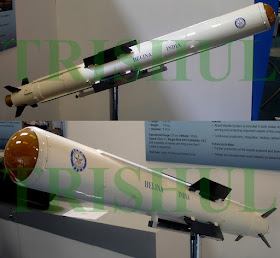Though the successful test-firings of
the Nag ATGM/NAMICA-2 combination passed its most crucial developmental
milestone on September 8 and 9, 2017, this has perhaps come too late and it now
remains to be seen if the Indian Army will conduct the definitive user-trials,
without which service-induction cannot take place.
It may be recalled that user-trials of
the 4km-range Nag ATGM’s uncooled LWIR sensor were carried out in hot desert
conditions in Rajasthan on July 28 and 29, 2012 at
the Mahajan firing range against both moving and static targets for different
ranges of 2.8km and 3.2km, with the ATGMs then being fired from the NAMICA-1 tracked
launchers.
Of the four missiles fired then, only one hit the target. In all,
eight firing-trials were planned, between July and August 4. On July 28, while
one Nag ATGM, tested for a range of 2,500 metres, hit the bull’s eye, the
second failed to destroy a target 700 metres away owing to a problem in its
uncooled LWIR sensor. In the subsequent trials on August 1, two Nag ATGMs
missed their targets positioned at 1,300 metres and 2,500 metres, respectively,
since there was inadequate thermal contrast for the LWIR sensor to lock-on and
track the target before the missile was launched. Consequently, the uncooled
LWIR sensor proved to be accurate only up to 2.5km in extremely hot conditions.
It was then that the Indian Army arbitrarily
moved the goalpost by demanding that the DRDO re-engineer the NAMICA-1 by
incorporating a commander’s panoramic target acquisition/lock-on sensor/
Undaunted, the DRDO rose up to the challenge and developed the NAMICA-2 (now
housing a COMPASS optronic panoramic turret procured by Bharat Electronics Ltd
from ELBIT Systems).
The DRDO also modified the LWIR sensor by incorporating IR-CCD
processor chips supplied by France’s ULIS-SOFRADIR. Since then, this modified sensor
has successfully engaged all eight of its targets—both fixed and moving.
Each NAMICA-2—destined for equipping the
Recce & Support Battalions of the Indian Army’s Mechanised Infantry
formations (especially when undertaking river-crossing operations)—can carry 12
Nag ATGMs, with six of them in ready-to-fire mode out to a distance of 4km. The
ATGM has a flight speed of 230 metres per second, is armed with a 8kg tandem
shaped-charge warhead, has a rocket motor using nitramine-based smokeless
extruded double base sustainer propellant, has a single-shot hit probability of
0.77 and a CEP of 0.9 metres, and has a 10-year maintenance-free shelf-life.
On
paper, the Indian Army remains committed to the procurement of 443 Bharat
Dynamics Ltd-built third-generation Nag fire-and-forget ATGMs along with 13 OFB
Medak-built NAMICA-2 tracked ATGM launchers.
Presently under development is the
helicopter-launched version of the Nag, known as HELINA. This ATGM uses the
same uncooled LWIR sensor as the Nag ATGM, and has a range of 7km. The HELINA,
using the ‘Rudrastra’ cannister-encased twin-launcher system, will arm both the
‘Rudra’ helicopter-gunships as well as the LCH attack helicopters of both the
Indian Army and Indian Air Force.
Under development is a DRDO-developed
active fire-and-forget, adverse-weather millimeter wave (MMW) radar sensor for
a 15km-range version of the HELINA. However, the R & D cycle of this ATGM is
unlikely to be completed by 2019 at the very latest, and consequently, the
Indian Army’s initial 60 HAL-developed ‘Rudra’ helicopter-gunships will in all
probability be armed with up to 960 HELINAs equipped with LWIR sensors.
NORINCO’s Answer To Nag/NAMICA-2

























